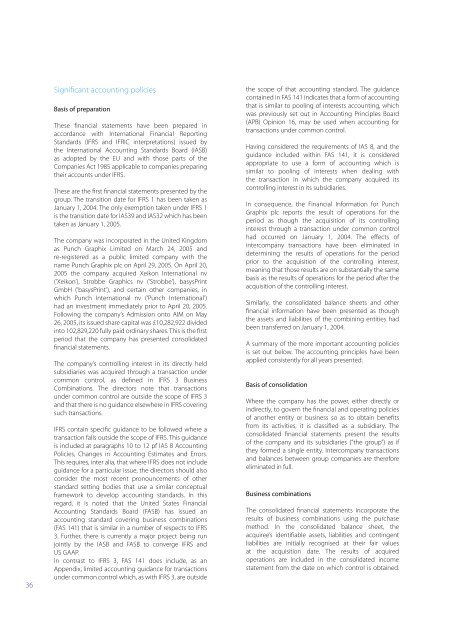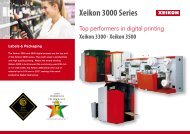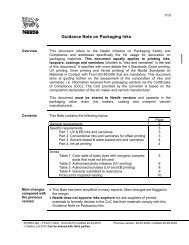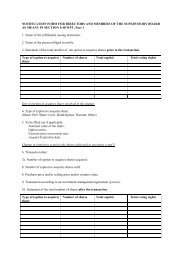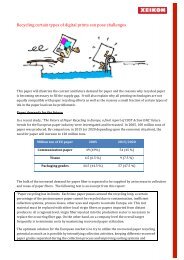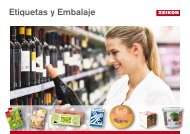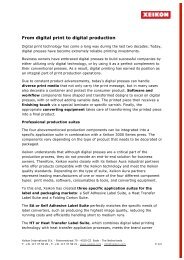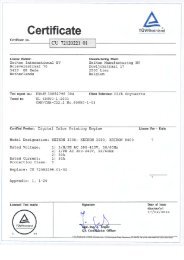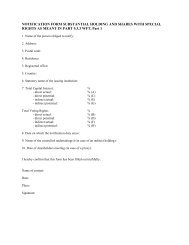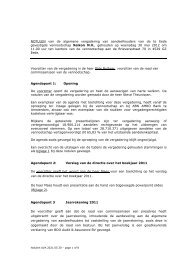Annual report 2005 - Xeikon
Annual report 2005 - Xeikon
Annual report 2005 - Xeikon
You also want an ePaper? Increase the reach of your titles
YUMPU automatically turns print PDFs into web optimized ePapers that Google loves.
36<br />
Significant accounting policies<br />
Basis of preparation<br />
These financial statements have been prepared in<br />
accordance with International Financial Reporting<br />
Standards (IFRS and IFRIC interpretations) issued by<br />
the International Accounting Standards Board (IASB)<br />
as adopted by the EU and with those parts of the<br />
Companies Act 1985 applicable to companies preparing<br />
their accounts under IFRS.<br />
These are the first financial statements presented by the<br />
group. The transition date for IFRS 1 has been taken as<br />
January 1, 2004. The only exemption taken under IFRS 1<br />
is the transition date for IAS39 and IAS32 which has been<br />
taken as January 1, <strong>2005</strong>.<br />
The company was incorporated in the United Kingdom<br />
as Punch Graphix Limited on March 24, <strong>2005</strong> and<br />
re-registered as a public limited company with the<br />
name Punch Graphix plc on April 29, <strong>2005</strong>. On April 20,<br />
<strong>2005</strong> the company acquired <strong>Xeikon</strong> International nv<br />
(‘<strong>Xeikon</strong>’), Strobbe Graphics nv (‘Strobbe’), basysPrint<br />
GmbH (‘basysPrint’), and certain other companies, in<br />
which Punch International nv (‘Punch International’)<br />
had an investment immediately prior to April 20, <strong>2005</strong>.<br />
Following the company’s Admission onto AIM on May<br />
26, <strong>2005</strong>, its issued share capital was £10,282,922 divided<br />
into 102,829,220 fully paid ordinary shares. This is the first<br />
period that the company has presented consolidated<br />
financial statements.<br />
The company’s controlling interest in its directly held<br />
subsidiaries was acquired through a transaction under<br />
common control, as defined in IFRS 3 Business<br />
Combinations. The directors note that transactions<br />
under common control are outside the scope of IFRS 3<br />
and that there is no guidance elsewhere in IFRS covering<br />
such transactions.<br />
IFRS contain specific guidance to be followed where a<br />
transaction falls outside the scope of IFRS. This guidance<br />
is included at paragraphs 10 to 12 pf IAS 8 Accounting<br />
Policies, Changes in Accounting Estimates and Errors.<br />
This requires, inter alia, that where IFRS does not include<br />
guidance for a particular issue, the directors should also<br />
consider the most recent pronouncements of other<br />
standard setting bodies that use a similar conceptual<br />
framework to develop accounting standards. In this<br />
regard, it is noted that the United States Financial<br />
Accounting Standards Board (FASB) has issued an<br />
accounting standard covering business combinations<br />
(FAS 141) that is similar in a number of respects to IFRS<br />
3. Further, there is currently a major project being run<br />
jointly by the IASB and FASB to converge IFRS and<br />
US GAAP.<br />
In contrast to IFRS 3, FAS 141 does include, as an<br />
Appendix, limited accounting guidance for transactions<br />
under common control which, as with IFRS 3, are outside<br />
the scope of that accounting standard. The guidance<br />
contained in FAS 141 indicates that a form of accounting<br />
that is similar to pooling of interests accounting, which<br />
was previously set out in Accounting Principles Board<br />
(APB) Opinion 16, may be used when accounting for<br />
transactions under common control.<br />
Having considered the requirements of IAS 8, and the<br />
guidance included within FAS 141, it is considered<br />
appropriate to use a form of accounting which is<br />
similar to pooling of interests when dealing with<br />
the transaction in which the company acquired its<br />
controlling interest in its subsidiaries.<br />
In consequence, the Financial Information for Punch<br />
Graphix plc <strong>report</strong>s the result of operations for the<br />
period as though the acquisition of its controlling<br />
interest through a transaction under common control<br />
had occurred on January 1, 2004. The effects of<br />
intercompany transactions have been eliminated in<br />
determining the results of operations for the period<br />
prior to the acquisition of the controlling interest,<br />
meaning that those results are on substantially the same<br />
basis as the results of operations for the period after the<br />
acquisition of the controlling interest.<br />
Similarly, the consolidated balance sheets and other<br />
financial information have been presented as though<br />
the assets and liabilities of the combining entities had<br />
been transferred on January 1, 2004.<br />
A summary of the more important accounting policies<br />
is set out below. The accounting principles have been<br />
applied consistently for all years presented.<br />
Basis of consolidation<br />
Where the company has the power, either directly or<br />
indirectly, to govern the financial and operating policies<br />
of another entity or business so as to obtain benefits<br />
from its activities, it is classified as a subsidiary. The<br />
consolidated financial statements present the results<br />
of the company and its subsidiaries (“the group”) as if<br />
they formed a single entity. Intercompany transactions<br />
and balances between group companies are therefore<br />
eliminated in full.<br />
Business combinations<br />
The consolidated financial statements incorporate the<br />
results of business combinations using the purchase<br />
method. In the consolidated balance sheet, the<br />
acquiree’s identifiable assets, liabilities and contingent<br />
liabilities are initially recognised at their fair values<br />
at the acquisition date. The results of acquired<br />
operations are included in the consolidated income<br />
statement from the date on which control is obtained.


